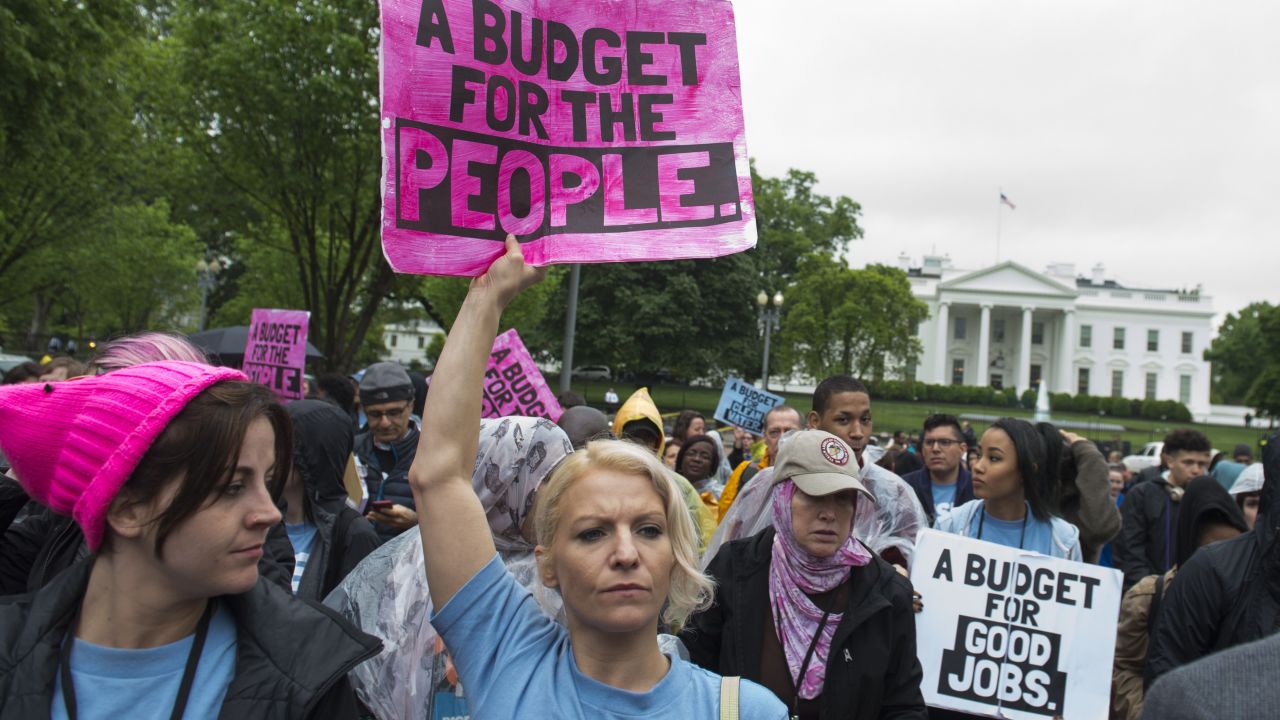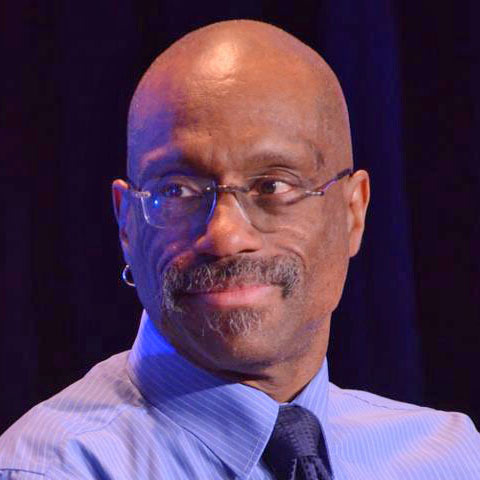
Protestors with People's Action rally against President Donald Trump's budget and agenda at Lafayette Park outside the White House in Washington, DC, April 25, 2017. (Photo by Saul Loeb/AFP/Getty Images)
This post originally appeared at OurFuture.org.
To people who argue that the resistance to President Trump amounts to protest without a plan, the Congressional Progressive Caucus has delivered a detailed and robust rebuke.
Its fiscal 2018 budget proposal, subtitled “A Roadmap for the Resistance,” is virtually a point-by-point rebuttal of Trump administration policies, and offers plans for completing the work of economic recovery that has been thwarted by Republican-imposed fiscal austerity that began with the tea party takeover of Congress in 2010.
It “provides a practical, progressive vision for our country by investing in 21st-century infrastructure and jobs, tackling inequality, making corporations pay their fair share and strengthening essential public programs. The People’s Budget will put millions of Americans back to work and will guarantee a strong economy for generations to come,” the budget document says.
It comes a week after People’s Action led close to 1,000 people in a rally in front of the White House to demand “a budget for the people.” Twelve people were arrested at that peaceful protest, which featured several testimonies from low-income people who would be harmed by cuts to vital government services proposed by the Trump administration.
“The Trump agenda will harm families, working people and students — people who are already struggling,” said Sonny Garcia of Illinois People’s Action, one of those arrested. “That’s why today I was arrested in front of the White House — we can’t afford more attacks on immigrant families and everyday working Americans.”
“Whether it’s the fight for science, fight for women’s rights, fight for tax justice, Americans are standing up and demanding that we have a budget that reflects their priorities, which are the priorities of the many over the money,” said Rep. Keith Ellison (D-MN), co-chair of the Progressive Caucus, during a news conference Tuesday outside the Capitol.
The caucus’s other co-chair, Rep. Raúl Grijalva (D-AZ), said it was important for progressives to offer the public “a stark contrast between the fear being promoted by Trump and the majority in Congress, and this budget that responds to the needs of the American people now and for the foreseeable future.”
The broad contours of the budget are similar to previous Progressive Caucus budgets. This year’s specifics include:
- A $2 trillion infrastructure and economic revitalization plan designed to “transform our energy, water and transportation systems.” It includes funding for bolstering renewable energy, high-speed broadband for rural communities and upgrading public school facilities.
- A number of measures designed to lower health care costs and move toward universal health care. They include allowing Medicare to negotiate lower prescription drug prices with medical corporations, and repealing the excise tax on so-called “Cadillac” health plans and authorizing a “public option” health insurance plan as a way to encourage lower insurance premiums.
- Measures to “tax Wall Street,” the wealthy and large corporations “to fund Main Street.” These taxes, combined with the expected economic growth from the spending provisions, would lead to a national debt that would actually be $4 trillion lower over 10 years than it would be under current law and well within tolerable levels for an economy of the United States’ size, according to an analysis by the Economic Policy Institute.
- Sufficient funding for a range of educational opportunities, beginning with universal pre-kindergarten and culminating with free tuition at public colleges and universities for students from low- and middle-income families.
- Prohibitions against funding President Trump’s proposed border wall with Mexico and his executive order banning entrants from six majority-Muslim countries into the US. It calls instead for “an immigration system that honors our values of inclusion, diversity and equality.”
- Ample funding for human needs and housing programs, rejecting Trump administration proposals to eliminate, slash or convert into state-managed and parsimoniously funded block grants programs that ensure all people are able to live in dignity.
Other policy changes called for in the budget include an increase in the federal minimum wage, changes in labor law to make collective bargaining easier and criminal justice reforms designed to “reduce unnecessary incarceration and the use of force.”
“It answers the question, ‘What do Democrats stand for?’,” said Rep. Barbara Lee (D-CA.). “It’s a bold statement of our principles and our commitment to the American people.”
Or at least it should be what Democrats stand for. But while a majority of Democrats did vote for the Progressive Caucus’ fiscal 2016 budget when it was put to a vote in March 2015 — the last time there were House budget resolution floor votes — more than 40 percent of Democrats joined Republicans at that time in voting against it.
But that was before the insurgent presidential campaign of Sen. Bernie Sanders showed Democrats that candidates can win votes with bold policies that would curb corporate power, require the wealthy to pay their fair share and put government back on the side of ordinary people.
And that was before the extremist policies of the Trump administration — particularly his attempted evisceration of health care for even many people in his own base — galvanized voters in an unprecedented wave of sustained resistance.
This time, Democrats have an opportunity to cast a vote for the economic growth and shared prosperity that Trump promised in his campaign but has proved unwilling or incapable of actually creating.
Become a citizen co-sponsor of the People’s Budget to encourage your member of Congress to seize this opportunity. Hundreds of thousands of citizen co-sponsors will signal to House Democrats that they have a popular mandate to vote for bold reforms that put people and planet first.
And that when it comes to economic prosperity, Democrats run a real political risk if they choose to play political footsie on with Trump and his congressional sycophants in a vain attempt to win mythical “centrist” voters.




